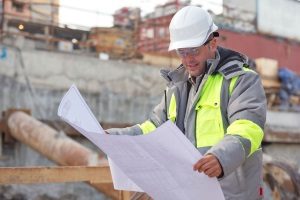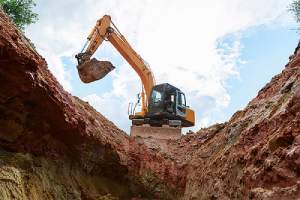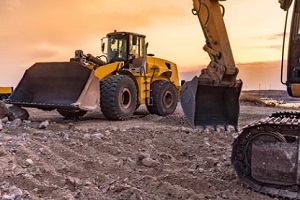Maximizing the Benefits of Structural Fill Dirt: A Comprehensive Guide
When constructing a solid foundation, structural fill dirt plays a crucial role. How can you maximize its benefits? This comprehensive guide covers all the essentials.
What is Structural Fill Dirt?
 Structural fill dirt, also known as engineered fill, mixes natural soil, gravel, sand, and sometimes clay. This material creates stable foundations for construction projects. It provides stability, drainage, and load-bearing capacity.
Structural fill dirt, also known as engineered fill, mixes natural soil, gravel, sand, and sometimes clay. This material creates stable foundations for construction projects. It provides stability, drainage, and load-bearing capacity.
Unlike ordinary topsoil used for landscaping, structural fill dirt withstands heavy loads. It provides a solid base for structures. It is commonly used in building foundations, road construction, embankments, and land reclamation. Its properties make it ideal for creating stable and level surfaces, preventing settling or shifting. Therefore, using structural fill dirt ensures the longevity and safety of your project.
Types of Dirt for Construction
When planning a construction project, choosing the right type of dirt is crucial. Different dirt types serve specific purposes. Understanding these classifications helps ensure your project’s success. From topsoil to gravel, each type offers unique benefits. Let’s explore the main types of dirt used in construction.
Different types of dirt are used in construction, each serving specific purposes. Here are the main classifications:
- Topsoil: Rich in organic matter, used for landscaping and gardening.
- Fill Dirt: Low in organic material, used to fill depressions and level land.
- Clay: High in clay particles, used for projects requiring strong compaction and moisture retention.
- Sandy Soil: Contains a high percentage of sand, used for areas needing good drainage.
- Silt: Fine particles, used for projects requiring smooth and stable surfaces.
- Gravel: Composed of small to medium-sized stones, used for foundations and drainage.
- Loam: A balanced mix of sand, silt, and clay, ideal for gardening and landscaping.
- Subsoil: Layer beneath topsoil, used in projects needing deeper foundational support
Uses and Benefits of Structural Fill Dirt
Structural fill dirt offers many benefits for construction projects. Its primary purpose is to provide a stable foundation, but it also offers other advantages.
- Stability: Structural fill dirt provides stability for construction projects. A well-compacted and graded fill dirt base withstands weight and pressure from structures, machinery, and traffic.
- Cost-Effectiveness: Using structural fill dirt can be a cost-effective solution compared to other materials like concrete or crushed stone. It is widely available and can often be sourced locally, reducing transportation costs.
- Load-Bearing Capacity: Structural fill dirt has a high load-bearing capacity, supporting heavy loads without significant settlement or deformation. This makes it essential for projects involving large structures or heavy equipment.
- Improved Drainage: Properly engineered fill dirt improves site drainage. Selecting the right type and ensuring proper compaction creates a surface that allows efficient water drainage, preventing water accumulation and structural damage.
- Versatility: Structural fill dirt is versatile and can be used for various projects, from residential construction to commercial buildings and road construction. It is also suitable for landscaping projects like creating level surfaces for gardens, parks, or sports fields.
By leveraging these benefits, you can enhance the quality and longevity of your construction projects.
Types of Structural Fill Dirt
Different types of structural fill dirt have unique properties suited for various projects.
- Sandy Fill Dirt: Sandy fill dirt, composed primarily of sand particles, is ideal for projects requiring good drainage. It is easy to compact and suitable for areas with high water tables.
- Clay Fill Dirt: Clay fill dirt contains a higher proportion of clay particles, providing cohesive properties. It is suitable for projects requiring high compaction and moisture retention, often used in areas with expansive soils.
- Gravel Fill Dirt: Gravel fill dirt, a mix of small to medium-sized stones and sand, is used for projects needing high load-bearing capacity, like road construction. It provides excellent drainage and stability.
- Mixed Fill Dirt: Mixed fill dirt combines different soil types like sand, clay, and gravel. It offers a balance of properties, making it suitable for a wide range of projects.
When choosing the right type of structural fill dirt, consider soil conditions, water drainage, and load requirements. Additionally, consulting with a geotechnical engineer or soil expert can help you make an informed decision.
Preparing the Site for Structural Fill Dirt Placement
Proper site preparation ensures successful placement and compaction of structural fill dirt. Follow these steps for optimal results.
First, clear the site by removing vegetation, debris, and obstructions. This process provides a clean and level surface for fill dirt placement. Next, conduct the necessary excavation to achieve the desired grade and elevation. Ensure uniform excavation, considering fill dirt thickness and compaction needs.
After excavation, prepare the subgrade by removing loose soil, compacting it, and ensuring proper drainage. The subgrade must remain stable and free from issues affecting fill dirt performance. Furthermore, control the moisture content of both the subgrade and fill dirt. Excessive moisture leads to poor compaction, while insufficient moisture makes fill dirt difficult to compact.
Consider installing a geotextile layer between the subgrade and fill dirt. Geotextiles separate materials, enhancing stability and providing additional reinforcement. Proper compaction is crucial for success. Use appropriate equipment to compact fill dirt in thin layers. Follow compaction specifications to achieve the required density.
By following these steps, you ensure a solid foundation for your project. Proper preparation reduces the risk of settling or structural issues, guaranteeing long-term stability.
Proper Methods for Placing and Compacting Structural Fill Dirt
 Placing and compacting structural fill dirt is critical for project stability. Follow these guidelines for optimal results.
Placing and compacting structural fill dirt is critical for project stability. Follow these guidelines for optimal results.
First, place fill dirt in thin, uniform layers to ensure proper compaction. Thick layers result in uneven compaction and reduced stability. Next, control moisture content during placement and compaction by using water to achieve the optimum moisture level for effective compaction.
After that, use appropriate equipment such as vibratory compactors or smooth drum rollers. Follow the manufacturer recommendations for equipment and techniques. Conduct compaction testing to ensure proper density and compaction. Use devices like a nuclear density gauge to measure density and moisture content accurately.
Additionally, control the lift height, which is the thickness of the fill dirt layer being compacted. Avoid excessive lift heights to ensure adequate compaction. By following these proper methods, you ensure the stability and durability of your construction project. Proper placement and compaction techniques are essential for long-term success and reliability.
Common Mistakes to Avoid When Using Structural Fill Dirt
Avoid these common mistakes to ensure the effectiveness and longevity of your project:
- Inadequate Site Preparation: Failing to prepare the site properly leads to poor compaction and stability issues. Therefore, clear the site and prepare the subgrade correctly.
- Incorrect Type of Fill Dirt: Choosing the wrong fill dirt type can compromise stability and load-bearing capacity. Hence, conduct soil tests and consult experts to select the right type.
- Improper Compaction: Inadequate compaction leads to settling and reduced stability. Follow recommended techniques and use appropriate equipment.
- Lack of Quality Control: Insufficient quality control measures result in poor performance. Regularly test compaction density and moisture content to meet required standards.
- Ignoring Environmental Considerations: Failing to consider environmental factors can have long-term consequences. Ensure compliance with local regulations and environmental guidelines.
By avoiding these mistakes, you can maximize the benefits of structural fill dirt and ensure project success.
Environmental Impact and Sustainability
Sustainable Sourcing: Choose suppliers that source structural fill dirt sustainably to minimize environmental impact. Seek suppliers committed to environmentally friendly practices that avoid disturbing natural ecosystems. Sustainable sourcing prevents habitat destruction and reduces carbon footprints. Ask suppliers about their sourcing techniques and verify their adherence to environmental standards and regulations. Prioritize sustainable sourcing to preserve natural landscapes and promote biodiversity. This ensures long-term ecological balance. Partnering with responsible suppliers benefits the environment and enhances your project’s eco-friendly reputation.
Recycled Materials: Incorporate recycled materials into your structural fill dirt mix to reduce waste and minimize environmental impact. Use materials like crushed concrete, asphalt, and reclaimed soil, which offer similar benefits as virgin fill dirt. Utilizing recycled content decreases the need for new material extraction and conserves natural resources. This approach reduces landfill waste and lowers greenhouse gas emissions from production and transportation. When selecting fill dirt, inquire about recycled options and ensure they meet your project’s specifications. By choosing recycled materials, you support a circular economy and demonstrate a commitment to sustainable construction practices.
Erosion Control: Implement effective erosion control measures to prevent soil erosion during and after construction. Techniques like silt fences, vegetation cover, and retaining walls stabilize the soil and protect against erosion. Silt fences act as barriers that trap sediment, preventing it from washing away. Additionally, vegetation cover, such as grass or native plants, anchors the soil with roots, reducing runoff. Retaining walls provide structural support and prevent soil displacement on slopes. By incorporating these methods, you enhance the durability of your fill dirt placement and safeguard surrounding ecosystems. Proper erosion control maintains site integrity and reduces the risk of environmental damage, ensuring long-term project success.
Advanced Techniques and Technologies
Geotechnical Engineering: Collaborate with geotechnical engineers to analyze soil properties and design effective structural fill dirt solutions. Geotechnical engineers conduct comprehensive soil tests to determine composition, compaction, and drainage capacity. Their expertise helps select the appropriate type of fill dirt and compaction methods tailored to specific project requirements. Understanding soil behavior under different conditions optimizes stability and performance. Geotechnical engineers ensure the longevity and safety of the structure. Their insights mitigate potential risks associated with soil instability, such as settling or erosion. Therefore, work with geotechnical engineers to ensure a scientifically informed approach, enhancing overall quality and reliability.
Soil Stabilization: Explore soil stabilization techniques to enhance structural fill dirt properties, improving durability and load-bearing capacity. Chemical stabilization involves adding materials like lime, cement, or fly ash to increase strength and stability. Geotextiles, synthetic fabrics placed within soil layers, provide reinforcement and prevent erosion. Soil reinforcement techniques, like geogrids or soil nails, enhance fill dirt’s structural integrity by evenly distributing loads. Implementing these methods ensures a resilient foundation capable of supporting heavy structures and withstanding adverse conditions. Soil stabilization extends the project’s life and reduces maintenance costs by preventing soil-related issues.
Monitoring and Maintenance: Regular monitoring and maintenance are crucial for sustaining the integrity of structural fill dirt and surrounding areas. Establish a routine inspection schedule to identify early signs of settling, erosion, or instability. Use tools like inclinometers and settlement plates to measure soil movement and compaction changes over time. Promptly addressing any detected issues can prevent minor problems from escalating into significant structural concerns. Maintenance activities might include re-compacting settled areas, repairing erosion control measures, and reinforcing weakened sections. Keeping detailed records of inspections and maintenance actions helps track the soil’s performance and anticipate future needs. Regular monitoring ensures your project’s foundation remains stable and reliable, safeguarding long-term success.
 The Importance of Proctor Testing for Soil Approval
The Importance of Proctor Testing for Soil Approval
Soils often need testing through a Proctor test to meet project requirements. The engineer on record presents this test to the project owner for approval.
Proctor Compaction Test
The Proctor compaction test determines the optimal moisture content for achieving maximum soil density. Ralph Roscoe Proctor introduced this test in 1933. It demonstrates the relationship between soil moisture and dry density.
These tests involve compacting soil with known moisture content into a cylindrical mold. A weighted hammer delivers controlled blows to the soil in layers. This process is repeated for different moisture levels, measuring dry density each time. The results create a compaction curve, identifying the peak dry density and corresponding optimal moisture content.
This test follows ASTM D698 and AASHTO T99 standards for the standard version. The modified test adheres to ASTM D1557 and AASHTO T180 standards. These procedures ensure consistency and reliability in determining soil compaction characteristics for construction projects.
Advanced Techniques and Technologies
Implementing advanced techniques and technologies enhances the effectiveness of structural fill dirt. Collaborating with geotechnical engineers ensures optimal analysis of soil properties, which leads to the best soil stabilization techniques. Techniques such as using lime and geotextiles improve both the durability and load-bearing capacity of fill dirt. Regular monitoring and maintenance, using tools like inclinometers to measure soil movement and compaction, are crucial for sustaining project stability. This approach guarantees the long-term reliability and success of your construction project.
Overview
Understanding the right type of dirt is essential for any construction project. This blog covers various types, including structural fill dirt, topsoil, fill dirt, clay, sandy soil, silt, gravel, loam, and subsoil. Each type serves a unique purpose and offers specific benefits. Proper selection and use of these materials ensure the stability and success of your project.
For expert advice and reliable services, contact Dirt Connections today. Let us help you choose the perfect dirt for your construction needs!
Summary

Dirt Connections was started with one goal in mind: providing quality residential and commercial construction services to clients on time and on budget. Reach out for more information on how we can support your next project.
For your convenience our estimates are free and by appointment. Call 703-940-9949 for a free estimate today!






